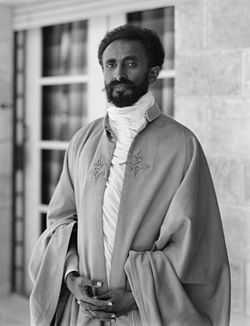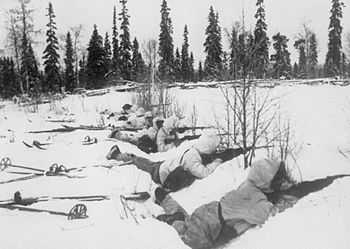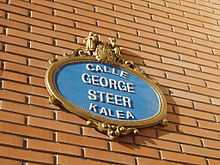George Steer
George Lowther Steer (1909 – 25 December 1944) was a South African-born British journalist, author and war correspondent who reported on wars preceding World War II, especially the Second Italo-Abyssinian War and the Spanish Civil War. During those wars he was employed by The Times, and his eye-witness reports did much to alert western nations of war crimes committed by the Italians in Ethiopia and by the Germans in Spain, although little was done to prevent them by the League of Nations.
Early life

George Steer was born in South Africa in 1909, the son of a newspaper manager. He studied classics in England, at Winchester College and Christ Church, Oxford. He began his journalistic career in South Africa, then worked in London for the Yorkshire Post.
War correspondent
In 1935 Steer covered the Italian invasion of Ethiopia for The Times and reported that Italian forces used mustard gas and bombed Red Cross ambulances.[1] He became friendly with Emperor Haile Selassie I of Ethiopia, who later became godfather to Steer's son.

In 1937 he was sent to report on the Spanish Civil War. He won prominence with his report on the bombing of Guernica on 26 April 1937. His telegram to London described German bomb casings and the use of thermite as an incendiary to create a firestorm in the center of the town. His reporting did much to inspire Pablo Picasso to record the atrocity for posterity in his massive painting.
The anti-Fascist tone of Steer's reporting led The Times to dispense with his services; the newspaper's editorial stance on the war was neutral, whilst its editor, Geoffrey Dawson, privately sympathised with the Nationalists under Francisco Franco. Steer returned to South Africa and, in his book Judgment on German Africa, documented Germany's attempts to subvert its former African colonies.


After the outbreak of World War II, the Daily Telegraph dispatched Steer to Finland to cover the Winter War. He saw the effects of aerial bombing of several Finnish towns by the Soviets, attempts made to intimidate the population, just like at Guernica.
Personal life
In May 1936, as looters ravaged Addis Ababa around him, and while taking a break from rescue work, Steer married French newspaper correspondent Margarita Herrero. A short while afterwards he was deported by the Italian authorities, along with other Europeans, for aiding the opposition Abyssinians.[2]
Margarita Steer died in childbirth in London while George Steer was reporting on the Spanish Civil War. He later married Esme Barton.
In 2006 the town of Guernica honored George Steer unveiling a bronze bust and naming a street in his memory.[3] Also in 2010 the City of Bilbao (Spain) dedicated George Steer Street, with Steer's son and granddaughter attending the ceremony.[4]
Military service and death
In June 1940 Steer joined the British Army and led an Ethiopian Forward Propaganda unit when British troops began to fight Italian troops in the country. After the defeat of the Italians in Ethiopia in 1941, Steer was influential in restoring Haile Selassie to the throne.[5] Later Steer was sent to India to lead a Field Propaganda Unit in Bengal. The unit tried to break Japanese morale by loudspeakers with speeches and sentimental music.
George Steer died in the crash of an Army Jeep, which he was driving, in Burma on 25 December 1944.
References
- ↑ Nicholas Rankin, 'Steer, George Lowther (1909–1944)’, Oxford Dictionary of National Biography, Oxford University Press, 2004
- ↑ Campagne d’Abyssinie, 05/1936 from this page
- ↑ Guernica honours Times man for telling its story
- ↑ (Spanish) "Bilbao dedica una calle a George Steer que informó del bombardeo de Gernika" Deia Retrieved 1 June 2013.
- ↑ Review of Telegram from Guernica: the extraordinary life of George Steer, war correspondent in the New Statesman 24 March 2003. Retrieved 19 January 2014.
Books by Steer
- Caesar in Abyssinia: An account of the Italo-Abyssinian war, 1935-6. With a map (1936).
- The Tree of Gernika: A field study of modern war. With plates and maps (1938).
- Germany in Africa. A series of articles dealing with the question of the former German African Colonies (1938).
- A Date in the Desert (1939).
- Judgment on German Africa (1939).
- Abyssinia to-day with W. Arnold-Forster (1939).
- Sealed and delivered : a book on the Abyssinian Campaign (1942).
Books about Steer
- Nicholas Rankin – Telegram from Guernica: The Extraordinary Life of George Steer, War Correspondent ISBN 0-571-20563-1, 2003, Faber and Faber
|